Photons & Fusion Newsletter
December 2012
Photons & Fusion is a monthly review of science and technology at the National Ignition Facility & Photon Science Directorate. For more information, submit a question.
Workshop Explores NIF's Unique Ability to Study Giant Planets
Topics ranging from the behavior of hydrogen and helium at extreme 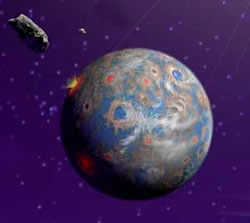 Artist's conception of an Earth-like giant planet. Credit: NASA JPLdensities to "surprises" in planetary physics research were explored at the Laboratory during a Dec. 7 workshop on the capabilities of NIF for studying the physics and chemistry of giant planets.
Artist's conception of an Earth-like giant planet. Credit: NASA JPLdensities to "surprises" in planetary physics research were explored at the Laboratory during a Dec. 7 workshop on the capabilities of NIF for studying the physics and chemistry of giant planets.
Led by LLNL's Rip Collins and Raymond Jeanloz of UC Berkeley, the 50-plus workshop attendees discussed ways the unprecedented temperatures and pressures created on the NIF can further researchers' understanding of the physics involved in the creation and evolution of planets. Also discussed was the science of materials subjected to pressures higher than one terapascal (ten million times Earth's atmospheric pressure).
Among the leading scientists participating in the workshop and serving as session chairs were (in order of sessions) David Stevenson, professor of planetary science at Caltech; Russ Hemley, director of the Geophysical Laboratory at the Carnegie Institution of Washington; Yogi Gupta, director of the Institute of Shock Physics at Washington State University; and Malcolm McMahon, Deputy Director of the Centre for Science at Extreme Conditions at the University of Edinburgh.
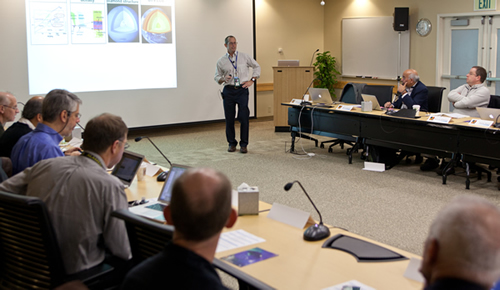 Rip Collins describes high-pressure materials experiments planned on NIF during the Dec. 7 Giant Planets Workshop.
Rip Collins describes high-pressure materials experiments planned on NIF during the Dec. 7 Giant Planets Workshop. Marking the Tenth Anniversary of the Alkali Resonance Laser
Dec. 11 was the Tenth Anniversary of the first demonstration of a resonance-transition alkali laser 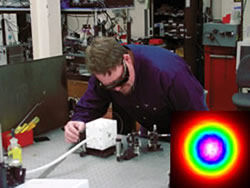 Keith Kanz adjusts the rubidium vapor cell oven on the rubidium-based alkali resonance laser in 2002. (Inset) Image of the laser pulse.using rubidium vapor, the first in a series of alkali-vapor lasers developed in the NIF & Photon Science Directorate over the past decade.
Keith Kanz adjusts the rubidium vapor cell oven on the rubidium-based alkali resonance laser in 2002. (Inset) Image of the laser pulse.using rubidium vapor, the first in a series of alkali-vapor lasers developed in the NIF & Photon Science Directorate over the past decade.
NIF&PS's Ray Beach, Sheldon Wu and Sasha Rubenchik were key contributors to the early development of these systems, which built on the alkali-vapor laser concepts developed by Z. Konefal and then by Bill Krupke (formerly of LLNL). These early systems serve as the basis for today's development of diode-pumped alkali lasers.
These alkali lasers are unique in that they are a hybrid of solid-state and gas lasers lineages, combining for the first time the best features from both families into a single laser system. Since the advent of lasers more than four decades ago, solid-state and gas lasers have followed largely divergent development paths: Gas lasers are typically pumped by direct electrical discharge or chemical reactions while solid-state lasers rely on flashlamps or semiconductor diode lasers. The defining features of these diode-pumped alkali-vapor lasers are the simple and lightweight laser systems that are enabled by a vapor-phase gain medium, and the intrinsic high efficiency enabled by diode pumping.
 Gina Bonanno of NIF & Photon Science demonstrates today’s diode-pumped alkali-vapor laser for Lt. Gen. Patrick O’Reilly, Director of the U.S. Missile Defense Agency.
Gina Bonanno of NIF & Photon Science demonstrates today’s diode-pumped alkali-vapor laser for Lt. Gen. Patrick O’Reilly, Director of the U.S. Missile Defense Agency. NIF Implosion Dynamics Measurements Reported in Physics of Plasmas
The results of in-flight implosion dynamics measurements during a recent series of NIF convergent ablator and related experiments were reported by inertial confinement fusion researchers in a Physics of Plasmas paper published online on Dec. 7.
The researchers said changes in capsule and hohlraum designs and laser pulse timing have improved the peak velocity of NIF implosions from 75 percent of required ignition velocity (nearly 700,000 mph) to 93 ± 5 percent of the ignition goal. In experiments with a cryogenically cooled layer of hydrogen fuel, using a 1.5-MJ laser pulse with a peak power of 420 TW, 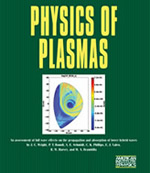 lengthening the pulse so the laser remained on until the capsule reached 30 percent (rather than 60-70 percent) of its initial radius reduced the shell thickness and improved the final fuel density; improved x-ray drive efficiency was observed using uranium instead of gold hohlraums and by slowing the rise time of the laser pulse.
lengthening the pulse so the laser remained on until the capsule reached 30 percent (rather than 60-70 percent) of its initial radius reduced the shell thickness and improved the final fuel density; improved x-ray drive efficiency was observed using uranium instead of gold hohlraums and by slowing the rise time of the laser pulse.
The experiments also indicated that instabilities seeded at the ablation front are a significant source of hydrodynamic mix of ablator material into the central hot spot (mixing of capsule material into the fuel reduces its compressibility and dilutes the fuel).
The researchers said the measurements showed that implosion velocity depends on the amount of ablator mass remaining during the implosion. "The (measurement) curve shows a lower-than-expected ablator mass at a given velocity," they said, "making the capsule more susceptible to feedthrough of instabilities from the ablation front into the fuel and hot spot. These results indicate the importance of undertaking a study of other ablator materials, particularly those with potentially improved rocket (implosion) efficiency."
The studies indicate that fuel capsules that are 20 microns (about 5 percent) thicker than current designs, along with laser powers at, or slightly beyond, NIF's current 500-terawatt capabilities, would be needed to achieve the implosion velocity and ablator mass remaining during implosions required for ignition, the researchers said. "A new generation of highly accurate measurements will be required to successfully navigate the path to ignition at the scale of about 2 MJ," they said. Lead author Damien Hicks of LLNL was joined by researchers from the Laboratory, Sandia National Laboratories, Massachusetts Institute of Technology, Los Alamos National Laboratory, and General Atomics of San Diego.
Holiday Spirit on Display Throughout NIF&PS
Members of the NIF & Photon Science Principal Directorate again participated in a variety of activities to help brighten the holidays for those in need:
Holiday Potluck and Silent Auction. This annual NIF&PS event, held on Dec. 11, raised approximately $6,000 to help provide a brighter holiday for 13 families in the Livermore and Tracy areas. The proceeds will be used to purchase grocery gift cards and other items for the families.
Brighter Holidays Giving Trees. Along with the auction, areas throughout NIF&PS "adopted" these families and created giving trees to hang tags describing items the families need or are on their wish lists.
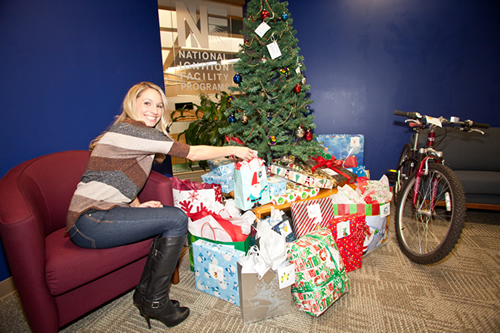 Photon Science & Applications’ Brighter Holidays coordinator Tara Silva arranges gifts beside the giving tree in the NIF&PS Directorate lobby.
Photon Science & Applications’ Brighter Holidays coordinator Tara Silva arranges gifts beside the giving tree in the NIF&PS Directorate lobby. HOME Campaign. NIF&PS employees donated $105,339 to LLNL's HOME (Helping Others More Effectively) campaign, with a participation rate of 46 percent. The NIF&PS contribution was boosted by $800 raised during a Nov. 30 Chili Cook-off.
"Once again, TeamNIF came through to help those in need," said NIF Director Ed Moses. "Thank you to everyone who participated, organized, or donated to any of our Brighter Holidays activities in 2012."




